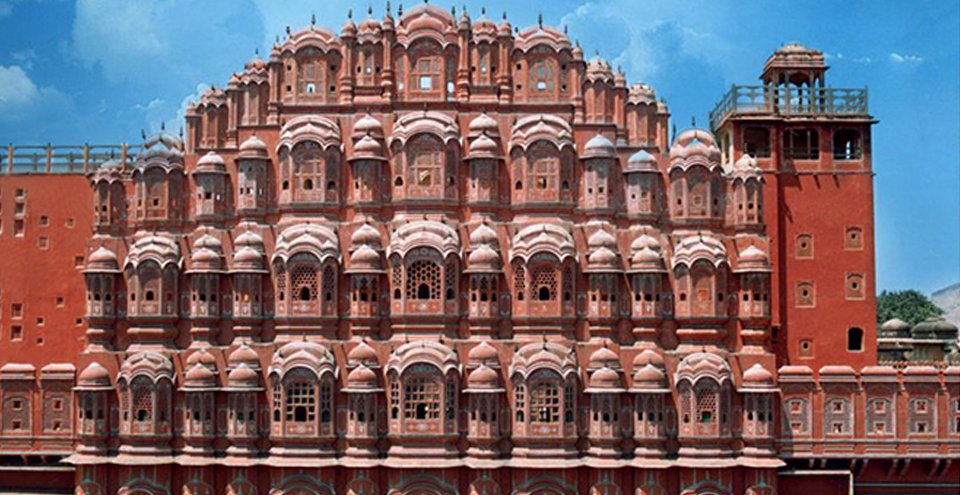
Hawa Mahal: The Palace of Winds
Located in the heart of Jaipur, Rajasthan, the Hawa Mahal stands as one of India’s most iconic landmarks. Renowned for its unique architectural design and historical significance, this palace is a must-visit destination for anyone exploring the Pink City. Here’s a detailed guide to understanding and experiencing the splendor of the Hawa Mahal.
A Glimpse into History
Hawa Mahal, which translates to “Palace of Winds,” was constructed in 1799 by Maharaja Sawai Pratap Singh, a ruler of the Kachwaha Rajput dynasty. The palace was designed by Lal Chand Usta, a prominent architect of the time. Its purpose was to provide the royal women of the court with a way to observe street festivities and daily life without being seen by the public, in line with the strict purdah system.
Architectural Marvel
The Hawa Mahal is celebrated for its distinctive architecture and striking facade. Its design is inspired by the crown of Krishna, the Hindu deity. Here are some key architectural features:
Facade: The palace’s facade is characterized by its 953 ornate windows, or “jharokhas,” which are decorated with intricate latticework. These windows allow cool air to flow through the palace, providing natural ventilation, which is how the palace earned its name.
Pink and Red Sandstone: Constructed from red and pink sandstone, the palace blends seamlessly with the surrounding cityscape. The use of these materials adds to its aesthetic appeal and contributes to the building’s harmony with Jaipur’s color scheme.
Five Stories: The palace has five stories, each with a series of jharokhas that offer panoramic views of the bustling streets below and the city beyond. The design includes a series of courtyards and open spaces that enhance the palace’s ventilation and light.
Architectural Style: The palace showcases a blend of Rajput and Mughal architectural styles. Its ornate design features a series of domed canopies and beautifully carved columns, reflecting the craftsmanship of the era.
Exploring the Palace
While the Hawa Mahal’s facade is its most iconic feature, the interior of the palace offers a fascinating exploration of royal life:
Interior Courtyards: The palace includes several courtyards that provide a glimpse into the layout and function of the building. These spaces are less elaborate than the facade but offer an interesting contrast to the ornate exterior.
Museum and Exhibits: The museum inside the palace displays artifacts and items related to the royal family, including portraits, traditional clothing, and various historical objects. These exhibits provide context and background about the palace and its occupants.
Rooftop Views: The rooftop of the Hawa Mahal offers stunning views of Jaipur and the surrounding Aravalli hills. It’s a perfect spot for photographs and for enjoying the panoramic scenery.
Practical Information for Visitors
Timings: The Hawa Mahal is open to visitors from 9:00 AM to 4:30 PM daily. It is advisable to check for any changes in timings before your visit.
Entry Fee: There is a nominal entry fee for Indian and foreign tourists. Tickets can be purchased at the entrance or through online booking platforms.
Guides: Hiring a local guide can enhance your visit by providing detailed insights into the history, architecture, and significance of the palace.
Tips for a Great Visit
Best Time to Visit: The cooler months from October to March are ideal for visiting Jaipur and exploring the Hawa Mahal, as the weather is more comfortable for sightseeing.
Dress Code: While there is no strict dress code, modest and comfortable clothing is recommended. Jaipur is a conservative city, so covering your shoulders and knees is respectful.
Photography: Photography is allowed in most areas of the palace. However, be mindful of any restrictions, especially in certain sections or museums.
Local Cuisine: After your visit, explore local eateries to sample traditional Rajasthani cuisine, including dishes like dal baati churma, ker sangri, and various sweets.
The Hawa Mahal is not just an architectural marvel but also a symbol of Jaipur’s rich heritage and royal splendor. Its unique design, historical significance, and panoramic views make it a must-visit attraction in the Pink City. Whether you’re fascinated by history, architecture, or simply enjoy exploring iconic landmarks, the Hawa Mahal promises an unforgettable experience that captures the essence of Rajasthan’s regal past.
So, when you find yourself in Jaipur, be sure to include the Hawa Mahal in your itinerary. It’s a place where history and beauty converge, offering a window into the grandiosity of the Rajput era and the vibrant life of one of India’s most storied cities.
